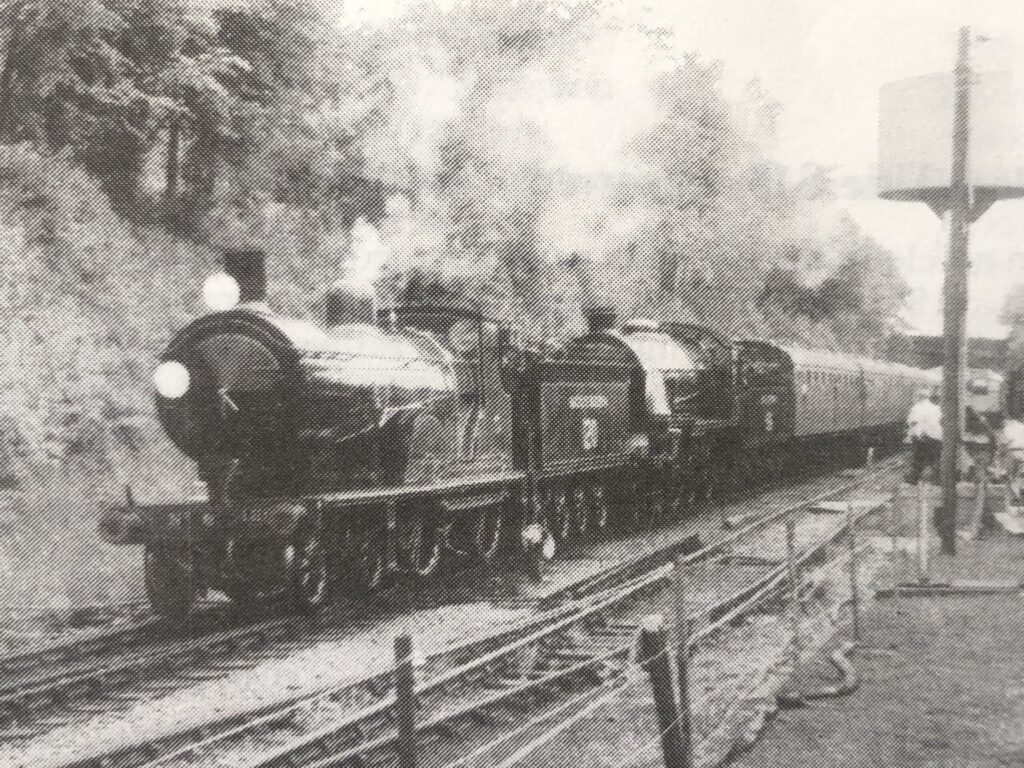Our delve into the Urie Society archives this time takes us back to 1988. A time when the society was the custodian of three engines, then including National Railway Museum’s T9 4-4-0 No 120 and the LSWR had been formed a mere 150 years ago.
Firstly, as was documented in our Autumn newsletter No3, 506’s mileage as released at the time from her first year back in service in 1987 was:
Figures are now available for the mileage recorded for No 506 in her first year back
in traffic. In 1987 the figures were:-
July (300), August (1,922), September (1,079), November/December (246)
Giving a total for 1987 of 3,547 miles.
For the first months of 1988 the figures were:-
March/April (567), May (668), June (782), July (436)
This makes a total of 2,453 miles so far this year, and a figure of exactly 6,000 for the first year back in operational use. The high figure for August 1987 was of course due to No. 506’s use during the period of daily running.
We are much indebted to the Mid-Hants Railway, for making these figures available, and to Tony Genever for gathering them together.

T9 4-4-0 No 120 double heading with Urie S15 506 at the Watercress Line in 1988
Urie S15s observed in the 20’s & 30’s
An article in the previous newsletter, concerning George Woodward’s observations of Urie S15s at Eastleigh around 1930, concentrated on the notes he recorded during full days spent observing the passing railway traffic. On these occasions he recorded everything he saw. At all other times he recorded anything he regarded as unusual; this article looks at these observations in the late 1920s and through the 1930s.
As the Urie S15s were primarily employed as goods engines, the most obvious out-of-the-ordinary working for them would be on “special goods” and there are plenty of these recorded. Besides those which are only given as “special goods” or “special vans” we also find such specific items as empty fish vans, a pigeon train, meat trains and a flower van train. Starting from about 1930 there are banana trains, both loaded and empty, and this traffic does not seem to have been particularly seasonal as it was recorded during most months of the year. George also recorded No. 497 on 3rd April 1936 on “special goods”, via Alton line, to Docks; a main line goods over the Mid-Hants line must have been quite rare at this period.
There are also a number of Urie SIS passenger workings recorded, including boattrains, excursions, and empty carriage stock. An unusual item occuring several times in the 1920s, but hardly ever in the 1930s, was “boat coaches off down train”. Coaches (usually two) would be detached at Eastleigh from a down express and would be worked to the Docks by a locomotive which would otherwise be running light to the Docks to take out a train.
Late in 1934 a series of entries begin which are recorded as “rubbish train to docks” At this point the New Docks at Southampton were being constructed, and trains came from all over the Southern system to bring cinders, clinker, old ballast, etc. from Motive Power depots and other places, for use as infill. Only one such working is recorded in 1934, but there are 25 in 1935 and 15 in 1936, but then none in 1937; this of course records only “rubbish trains”worked by Urie S15s, which suggests there must have been quite a lot of them in all. T14s were regulars on these trains.
From late in 1936, the Urie S15s appeared to move occasionally into a more cultured world – they are recorded working. “theatre train”. This late night train ran Saturdays and Wednesdays when required and was officially empty stock from Eastleigh to Southampton (but sometimes carried passengers); at Southampton it picked up theatregoers and deposited them at stations to Salisbury. It was sometimes worked by an S15 whose rostered Salisbury goods working had no traffic available.
Another series of special workings recorded by George are of particular interest to followers of the Mid-Hants Railway. In the early days of the Mid-Hants, whenever anew engine arrived on the line the reports invariably seemed to say “No XXX must have worked over the Mid-Hants line many times”; but one did wonder if this wasreally true. For the Urie S15s, George Woodwoard gives us evidence, as for him such an engine on one of the through trains over the Alton line (these ran until 1937) was an unusual working, and therefore something he recorded. He records eight such workings:
| Date | No. | Working | Time |
|---|---|---|---|
| 28/07/27 | E513 | Waterloo-Alton-Southampton | 4.05pm |
| 13/06/28 | E499 | Waterloo-Alton-Southampton | 10.05am |
| 25/08/34 | 499 | Eastleigh-Alton-Waterloo | 9:00am |
| 27/07/35 | 499 | Waterloo-Alton-Southampton | 10:00am |
| 09/05/36 | 502 | Eastleigh-Alton-Waterloo | 9:00am |
| 03/06/36 | 509 | Waterloo-Alton-Eastleigh | 7:00pm |
| 19/06/36 | 509 | Southampton-Alton-Waterloo | 6:50pm |
| 27/10/36 | 499 | Waterloo-Alton-Southampton | 10:00am |
This tells us nothing about No. 506, but it does show us that No. 499 can definitelyclaim previous associations with the Mid-Hants. Indeed, on this showing, No. 499seems to have been quite a favourite among Urie S15s on the line.

52 thoughts on “Urie locomotives in the 20’s & 30’s”